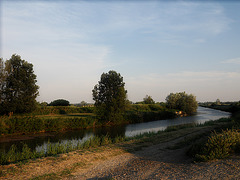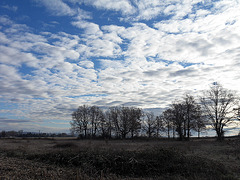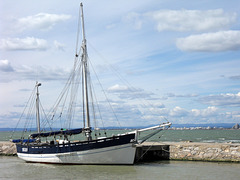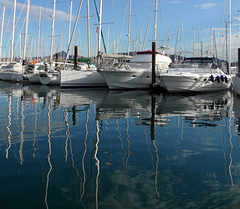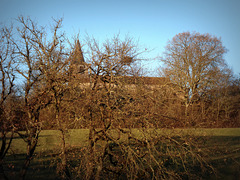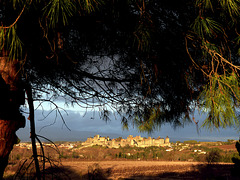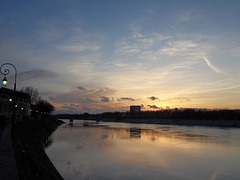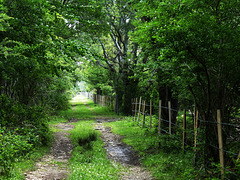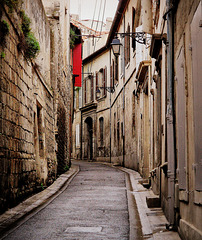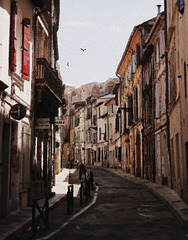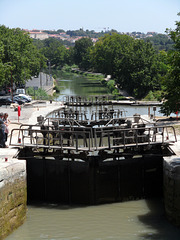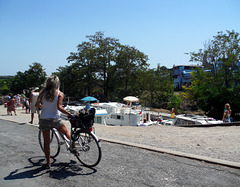
Francia - France
paesaggio e città della bella Francia
il canale di Van Gogh
| |
|
|
|
Arles - Provence - France
PiP
In realtà il suo famoso ponte non era esattamente qui e non esiste più, ma la città di Arles ne ha acquistato uno molto simile dalla città di Fos-sur-mer, poco lontano, da dove era stato smantellato per far posto a uno che sopportasse il passaggio delle auto.
Do not use any of my images on websites, blogs or other media without my explicit written permission.
All rights reserved - Copyright © fotomie2009 - Nora Caracci
pecorelle nel cielo
| |
|
|
|
10 anni fa ...
Da molti anni ormai eravamo soliti passare l'ultimo dell'anno con degli amici francesi, ci si incontrava da loro o da noi, oppure a metà strada.
Questa foto è stata scattata in occasione di uno dei nostri trasferimenti.
Ma quest'anno ... nessun rendez-vous, purtroppo.
Ci rifaremo !!!
Campagna nel Gers - France
Originariamente pubblicata nel maggio 2013 per:
10-Week Picture Projects: TREES, Week 3: Tree(s) without Leaves
-------------------------------------------------------------
Do not use any of my images on websites, blogs or other media without my explicit written permission.
All rights reserved - Copyright © fotomie2009 - Nora Caracci
old farm and old-fashioned picture
| |
|
|
|
Tieste Uragnoux - Gers - France
Do not use my images on websites, blogs or other media without my explicit written permission.
All rights reserved - Copyright © Nora Caracci
Le Grau du Roi
| |
|
|
|
A village in the Petite Camargue. At the beginning only some fishing cottages, it gained importance in the sixteenth century when the Rhone created a new channel directly from Aigues Mortes to the sea. Later on this communication became a canal, in the picture you see its last part, just before flowing into the sea.
The village of fishers and farmers became a separate commune in 1879 and turned to tourism at the end of the 19th century. Nowadays is still very frequented by tourists.
Do not use any of my images on websites, blogs or other media without my explicit written permission.
All rights reserved - Copyright © Nora Caracci
riflessi danzanti a Hendaye
| |
|
|
|
Hendaye (Basque: Hendaia) is the most south-westerly town and commune in France, lying in the Pyrénées-Atlantiques department and located in the traditional province Lapurdi (Labourd) of the French Basque Country. The town is a popular seaside tourist resort by the Atlantic coast, the "Côte Basque", lying at the same time on the right bank of the river Bidassoa, which marks the border with Irún, Spain.
Do not use any of my images on websites, blogs or other media without my explicit written permission.
All rights reserved - Copyright © Nora Caracci
Ricami riflessi
| |
|
|
|
Préchac Sur Adour - Gers - France
Do not use any of my images on websites, blogs or other media without my explicit written permission.
All rights reserved - Copyright © Nora Caracci
Notre Dame de Castex - Ladevèze Ville
| |
|
|
|
Ladevèze-Ville (La Devesa Vila en gascon) est une petite commune française située dans le département du Gers et la région Midi-Pyrénées.
Jusqu'à la Révolution les communes actuelles de Ladevèze Ville et Ladevèze Rivière formaient une unique communauté "La Deveze" ou Ladevèze. Le centre de cette communauté était le bourg de Ladevèze Ville appelé "La ville". C'était autrefois "un des plus importants Castelnaux de la Gascogne". Ce bourg s'est peu à peu dépeuplé. Mais il subsiste encore des vestiges importants de son enceinte médiévale.
L’église de Castex est une église de fondation romane de 22,60 m de long sur 6,20 m de large. On entre dans l’église par une porte placée au nord sous un porche rustique (une autre ouverture, aujourd’hui murée, existait côté clocher-mur). Dans le sanctuaire s’élève une hayère en bois sculpté, avec jours, accoudoirs et haut dossier surmonté d’un dais, datable de la fin du XVe siècle et classée par décret du 26 août 1938.
Do not use any of my images on websites, blogs or other media without my explicit written permission.
All rights reserved - Copyright © Nora Caracci
Tariquet - Domaine Caillaubert
| |
|
|
|
Questo è il viale d'ingresso a una delle tenute dei Tariquet, produttori di vino da più di 100 anni in Guascogna.
Iniziarono con l'Armagnac, ma ora hanno anche una ampia gamma di vini esportati anche in U.S.A., prodotti in vaste tenute piano piano acquisite nei dintorni. Sono loro ad aver fatto conoscere ed apprezzare i vini di questa regione, portandoli ad alto livello di qualità con innovazioni anche tecnologiche come per esempio una macchina vendemmiatrice con annessa diraspatrice in modo da risparmiare tempo ed evitare ossidazione.
La sede principale, Chateau de Tariquet, è non lontano di qui, ve lo mostrerò un'altra volta...
Do not use any of my images on websites, blogs or other media without my explicit written permission.
All rights reserved - Copyright © Nora Caracci
Carcassonne dopo un acquazzone
| |
|
|
|
Le prime tracce di insediamento nella regione di Carcassonne, sono state datate al 3500 a.C. Attorno all'800 a.C., la collina di Carsac divenne un importante luogo di scambi commerciali.
Carcassonne divenne strategicamente importante quando i Romani fortificarono la cima della collina attorno all'anno 100 a.C. e resero il centro capitale della colonia di Julia Carcaso, in seguito Carcasum. La parte principale delle mura settentrionali risale a quell'epoca.
Le fortificazioni furono via via rafforzate o distrutte nell'arco dei secoli e nell'800 la cittadella fortificata di Carcassonne era ormai in rovina; a tal punto che il governo francese considerò seriamente la sua demolizione. Un decreto in tal senso venne reso ufficiale nel 1849, ma causò un tumulto. Lo storico Jean-Pierre Cros-Mayrevielle e lo scrittore Prosper Mérimée, guidarono una campagna per preservare la fortezza come monumento storico. In seguito, nello stesso anno, l'architetto Eugène Emmanuel Viollet-le-Duc venne incaricato del rinnovamento del luogo.
Il restauro della città fortificata costituisce un caso di studio nell'ambito dei corsi di restauro; Viollet-le-Duc sintetizzo così il suo approccio ai lavori di restauro del castello: "Restaurare un edificio, non è solo mantenerlo, ripararlo, o ricostruirlo, è riportarlo ad una condizione completa che potrebbe non essere mai esistita".
Il pensiero del francese Le-Duc in materia di restauro era all'opposto di quello dell'inglese John Ruskin che negli stessi anni teorizzava un modello romantico di restauro conservativo che alterasse il meno possibile i monumenti e che doveva mostrare, e non nascondere, i segni del tempo. L'architetto francese si attenne rigorosamente ai suoi principi in occasione dei restauri del castello e l'edificio divenne così l'emblema stesso del restauro stilistico e fonte di accese critiche da parte degli architetti e restauratori favorevoli all'approccio conservativo, che lo accusavano di aver inventato di sana pianta parti del castello.
A me non dispiace affatto il risultato, e a voi ?
Do not use any of my images on websites, blogs or other media without my explicit written permission.
All rights reserved - Copyright © Nora Caracci
Framing Carcassonne
| |
|
|
|
The fortified city consists essentially of a concentric design with two outer walls with towers and barbicans to prevent attack by siege engines. The castle itself possesses its own drawbridge and ditch leading to a central keep. The walls consist of towers built over quite a long period. One section is Roman and is notably different from the medieval walls with the tell-tale red brick layers and the shallow pitch terracotta tile roofs. One of these towers housed the Catholic Inquisition in the 13th Century and is still known as "The Inquisition Tower".
Carcassonne was struck off the roster of official fortifications under Napoleon and the Restoration, and the fortified cité of Carcassonne fell into such disrepair that the French government decided that it should be demolished. A decree to that effect that was made official in 1849 caused an uproar. The antiquary and mayor of Carcassonne, Jean-Pierre Cros-Mayrevieille, and the writer Prosper Mérimée, the first inspector of ancient monuments, led a campaign to preserve the fortress as a historical monument. Later in the year the architect Eugène Viollet-le-Duc, already at work restoring the Basilica of Saint-Nazaire, was commissioned to renovate the place.
In 1853, works began with the west and southwest walling, followed by the towers of the porte Narbonnaise and the principal entrance to the cité. The fortifications were consolidated here and there, but the chief attention was paid to restoring the roofing of the towers and the ramparts, where Viollet-le-Duc ordered the destruction of structures that had encroached against the walls, some of them of considerable age. Viollet-le-Duc left copious notes and drawings on his death in 1879, when his pupil Paul Boeswillwald, and later the architect Nodet continued the rehabilitation of Carcassonne.
The restoration was strongly criticized during Viollet-le-Duc's lifetime. Fresh from work in the north of France, he made the error of using slates and restoring the roofs as point-free environment. Yet, overall, Viollet-le-Duc's achievement at Carcassonne is agreed to be a work of genius, though not of the strictest authenticity.
I like the result of the restoration, and you ?
Do not use any of my images on websites, blogs or other media without my explicit written permission.
All rights reserved - Copyright © Nora Caracci
vecchia strada
| |
|
|
|
nella Crau francese; questo viale alberato era un'arteria importante al tempo in cui passavano le carrozze, ora è rimasto unicamente come collegamento ad accessi privati, lo vado spesso a trovare e di anno in anno lo trovo sempre meno curato.
Explored
Do not use any of my images on websites, blogs or other media without my explicit written permission.
All rights reserved - Copyright © Nora Caracci
Tramonto sul Rodano
| |
|
|
|
Ad Arles, Provenza, Francia
altri nomi di questo importante fiume europeo (nasce in Svizzera dove scorre per 231 km per poi proseguire in Francia per altri 581 km, fino a sfociare nel Mar Mediterraneo):
Rhône in francese
Rôno in arpitano
Ròse in occitano
Rhone o Rotten in tedesco
Rhodanus in latino
Rhodanòs - Ροδανός in greco antico
Explored
Do not use any of my images on websites, blogs or other media without my explicit written permission.
All rights reserved - Copyright © Nora Caracci
il verde brillante della Crau
| |
|
|
|
cambio data di pubblicazione per augurare a tutti HFF !!!
La Crau est l'ancien delta de la Durance est le dernier désert français et les espèces qu'il abrite sont toutes exceptionnelles. La Crau est bien évidemment un site Nature. Son accès est par contre plus délicat et il n'est pas toujours évident d'observer correctement les oiseaux à cause de l'immensité et de l'uniformité des lieux. Mieux vaut vous renseigner au préalable à l'Écomusée de la Crau qui se trouve à St-Martin-de-Crau. Les sites accessibles se trouvent au nord près de St-Martin ou à l'est au sud d'Entressen. L'espèce phare est bien entendu le farouche ganga cata qui ne vit en France qu'en Crau mais d'autres comme le faucon crécerellette (présent de la mi-avril à juillet), l'alouette calandre et l'outarde canepetière méritent le détour. La pie-grièche méridionale y est régulière alors que la pie-grièche à poitrine rose ne s'y reproduit plus que très irrégulièrement. Parmi les espèces plus communes, on notera le rollier d'Europe, l'alouette calandrelle, la pie-grièche à tête rousse, la chevêche d'Athéna et l’œdicnème criard. Le vautour percnoptère et le circaète Jean-le-Blanc y font de régulières incursions en provenance des Alpilles. Le pipit de Richard, quoique très rare, est devenu depuis plusieurs années un hivernant régulier.
(voir dans la note un oiseau vu là bas)
Explored
Do not use any of my images on websites, blogs or other media without my explicit written permission.
All rights reserved - Copyright © Nora Caracci
strade di Arles
| |
|
|
|
Città dalla storia lunga e gloriosa, Arles.
Da emporio commerciale greco-massaliota, assunse caratteristiche propriamente urbane in età romana, divenendo una delle metropoli più fiorenti delle Gallie.
In epoca medievale fu capitale di uno stato, il regno di Arles, che si estese per gran parte della Francia centro-orientale e sud-orientale e dell'odierna Svizzera.
Questo scorcio è nel centro storico medioevale, qui tutte le strade in salita portano alla cima di un'altura dove ci sono prestigiosi monumenti romani, tra i quali molto ben conservato è l'anfiteatro edificato intorno all'80 d.C, di notevoli dimensioni, ancora oggi utilizzato per spettacoli di vario genere.
Do not use any of my images on websites, blogs or other media without my explicit written permission.
All rights reserved - Copyright © Nora Caracci
Arlésienne
| |
|
|
|
Arles e la sua gente sono state fonti di ispirazione per letterati, musicisti e pittori: L'Arlésienne (L'Arlesiana) è il titolo di un racconto di Alphonse Daudet che ispirò un dramma musicale in tre atti composto da Georges Bizet, mentre l'opera lirica L'Arlesiana, sempre tratta dal racconto di Daudet in una rielaborazione di Leopoldo Marenco, fu musicata da Francesco Cilea. L'Arlesiana è anche il titolo di due celebri dipinti di Vincent van Gogh (il primo del 1888 e il secondo del 1890).
Ma Van Gogh vi soggiornò a lungo e sono tanti gli scorci di Arles da lui immortalati magnificamente.
Questa mia edizione pittorica non ha il suo stile, ma vuole essere un omaggio al grande pittore.
Chi ama la lirica qui può ascoltare Il Lamento di Federico dall'Arlesiana di Cilea interpretato da Luciano Pavarotti .
Do not use any of my images on websites, blogs or other media without my explicit written permission.
All rights reserved - Copyright © Nora Caracci
Fonséranes - Les neuf écluses (série)
| |
|
|
|
Canal du Midi, voisin a Béziers. (Fonséranes ou Fonserranes)
Pour les puristes de la langue française, il convient tout de même de signaler qu'il ne s'agit pas de neuf écluses (8 bassins et 9 vannes), mais d'une seule et unique écluse! En fait, c'est une écluse octuple :)
9 ou 1 n'emporte, c'est un spectacle !
Ici nous somme a peu pres a la fin de cette œuvre monumentale (voir les photos dans les commentaires prises en bas) avant la dernière écluse qui aujourd'hui est en fonction.
Construction: deuxième moitié du XVII siècle.
Do not use any of my images on websites, blogs or other media without my explicit written permission.
All rights reserved - Copyright © Nora Caracci
Fonseranes - Le 9 chiuse del Canal du Midi
| |
|
|
Il commercio di frumento nel XVII secolo era fiorente e necessitava di infrastrutture per il trasporto delle merci. Per tale motivo Jean-Baptiste Colbert, controllore generale delle finanze di Luigi XIV autorizzò la costruzione di un canale per favorire gli scambi commerciali evitando il passaggio obbligatorio attraverso lo stretto di Gibilterra. Colbert autorizzò l'innalzamento dell'opera con il decreto reale dell'ottobre 1666. Ideatore, promotore e progettista fu Pierre-Paul Riquet, precedentemente esattore delle imposte, francese nato a Béziers, che diresse i lavori, iniziati appunto nel 1666 e terminati nel 1681.
Quello che oggi si chiama Canal du Midi ha 103 chiuse che servono a superare un dislivello totale di 190 metri. Nei pressi di Béziers c'era un grosso dislivello, 25 metri da superare in un tratto di 300 metri circa; furono necessarie allora ben 9 chiuse (8 bacini e 9 porte); l'opera monumentale fu progettata da Michel e Pierre Medailhes. Oggi solo 7 chiuse vengono ancora utilizzate, dopo la costruzione del Ponte-Canale sopra il fiume Orb.
qui sotto la visione dall'alto (cliccabile)
Do not use any of my images on websites, blogs or other media without my explicit written permission.
All rights reserved - Copyright © Nora Caracci
Fonseranes - Le 9 chiuse
| |
|
|
|
Lo spettacolo delle 9 chiuse del Canal du Midi vicino a Béziers attira sempre, eravamo in tanti a seguire le operazioni per passare tutte queste chiuse rese necessarie dal dislivello di 25 metri tra il canale a monte e il suo arrivo al mare.
Per la precisione si tratta di 8 bacini di forma ovoidale molto caratteristica e nove porte, l'ultimo dei quali ora non è più in funzione, dopo la costruzione del ponte-canale per passare sopra al fiume Orb (nella foto in commento la via verso tale ponte).
L'opera monumentale fu progettata da Michel e Pierre Medailhes e realizzata nella seconda metà del 1600.
(ho trovato due modi di scrivere il nome del sito: Fonséranes o Fonserranes)
Do not use any of my images on websites, blogs or other media without my explicit written permission.
All rights reserved - Copyright © Nora Caracci
Jump to top
RSS feed- Latest items - Subscribe to the latest items added to this album
- ipernity © 2007-2024
- Help & Contact
|
Club news
|
About ipernity
|
History |
ipernity Club & Prices |
Guide of good conduct
Donate | Group guidelines | Privacy policy | Terms of use | Statutes | In memoria -
Facebook
Twitter

